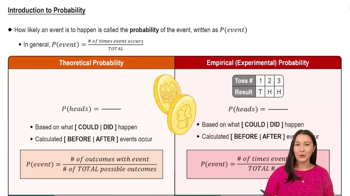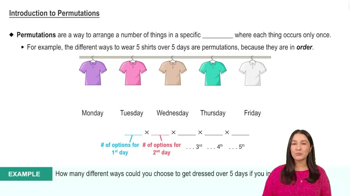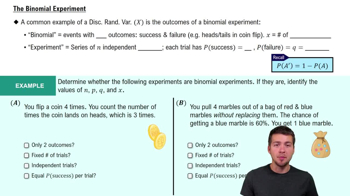Social Security Numbers A Social Security number consists of nine digits in a particular order, and repetition of digits is allowed. After seeing the last four digits printed on a receipt, if you randomly select the other digits, what is the probability of getting the correct Social Security number of the person who was given the receipt?
Table of contents
- 1. Intro to Stats and Collecting Data1h 14m
- 2. Describing Data with Tables and Graphs1h 55m
- 3. Describing Data Numerically2h 5m
- 4. Probability2h 16m
- 5. Binomial Distribution & Discrete Random Variables3h 6m
- 6. Normal Distribution and Continuous Random Variables2h 11m
- 7. Sampling Distributions & Confidence Intervals: Mean3h 23m
- Sampling Distribution of the Sample Mean and Central Limit Theorem19m
- Distribution of Sample Mean - Excel23m
- Introduction to Confidence Intervals15m
- Confidence Intervals for Population Mean1h 18m
- Determining the Minimum Sample Size Required12m
- Finding Probabilities and T Critical Values - Excel28m
- Confidence Intervals for Population Means - Excel25m
- 8. Sampling Distributions & Confidence Intervals: Proportion1h 12m
- 9. Hypothesis Testing for One Sample3h 29m
- 10. Hypothesis Testing for Two Samples4h 50m
- Two Proportions1h 13m
- Two Proportions Hypothesis Test - Excel28m
- Two Means - Unknown, Unequal Variance1h 3m
- Two Means - Unknown Variances Hypothesis Test - Excel12m
- Two Means - Unknown, Equal Variance15m
- Two Means - Unknown, Equal Variances Hypothesis Test - Excel9m
- Two Means - Known Variance12m
- Two Means - Sigma Known Hypothesis Test - Excel21m
- Two Means - Matched Pairs (Dependent Samples)42m
- Matched Pairs Hypothesis Test - Excel12m
- 11. Correlation1h 6m
- 12. Regression1h 50m
- 13. Chi-Square Tests & Goodness of Fit1h 57m
- 14. ANOVA1h 57m
4. Probability
Counting
Problem 4.4.18
Textbook Question
Teed Off When four golfers are about to begin a game, they often toss a tee to randomly select the order in which they tee off. What is the probability that they tee off in alphabetical order by last name?
 Verified step by step guidance
Verified step by step guidance1
Step 1: Understand the problem. The goal is to calculate the probability that four golfers tee off in alphabetical order by last name. This involves determining the total number of possible orders and identifying the specific order that matches the alphabetical arrangement.
Step 2: Calculate the total number of possible orders. Since there are four golfers, the number of ways they can be arranged is given by the factorial of 4, denoted as 4!. The formula for factorial is n! = n × (n-1) × (n-2) × ... × 1. For 4 golfers, this would be 4 × 3 × 2 × 1.
Step 3: Identify the favorable outcome. There is only one specific arrangement where the golfers tee off in alphabetical order by last name. This is the favorable outcome.
Step 4: Calculate the probability. The probability of an event is given by the formula P(Event) = (Number of favorable outcomes) / (Total number of possible outcomes). Substitute the values: the number of favorable outcomes is 1, and the total number of possible outcomes is 4!.
Step 5: Simplify the expression. To find the probability, simplify the fraction using the value of 4! calculated earlier. This will give the final probability that the golfers tee off in alphabetical order by last name.
 Verified video answer for a similar problem:
Verified video answer for a similar problem:This video solution was recommended by our tutors as helpful for the problem above
Video duration:
2mPlay a video:
Was this helpful?
Key Concepts
Here are the essential concepts you must grasp in order to answer the question correctly.
Probability
Probability is a measure of the likelihood that a particular event will occur, expressed as a number between 0 and 1. In this context, it quantifies the chance of the golfers teeing off in a specific order, which can be calculated by considering all possible arrangements of the golfers.
Recommended video:

Introduction to Probability
Permutations
Permutations refer to the different ways in which a set of items can be arranged in order. For four golfers, the total number of permutations is calculated as 4! (4 factorial), which equals 24. This concept is essential for determining the total possible outcomes when arranging the golfers.
Recommended video:

Introduction to Permutations
Favorable Outcomes
Favorable outcomes are the specific outcomes that satisfy the condition of interest—in this case, the golfers teeing off in alphabetical order. Since there is only one specific arrangement that meets this criterion among the total permutations, understanding favorable outcomes is crucial for calculating the probability.
Recommended video:
Guided course

The Binomial Experiment

 7:11m
7:11mWatch next
Master Introduction to Permutations with a bite sized video explanation from Patrick
Start learningRelated Videos
Related Practice
Textbook Question
